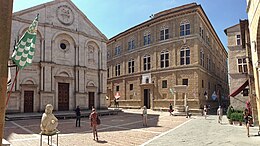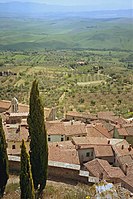Pienza
| Pienza | ||
|---|---|---|

|
|
|
| Country | Italy | |
| region | Tuscany | |
| province | Siena (SI) | |
| Coordinates | 43 ° 5 ' N , 11 ° 41' E | |
| height | 491 m slm | |
| surface | 122.5 km² | |
| Residents | 2,058 (Dec. 31, 2019) | |
| Population density | 17 inhabitants / km² | |
| Post Code | 53026 | |
| prefix | 0578 | |
| ISTAT number | 052021 | |
| Popular name | Pientini | |
| Patron saint |
Sant'Andrea (November 30th) |
|
| Website | Pienza | |
 Panorama of Pienza |
||
Pienza is an Italian city with 2058 inhabitants (as of December 31, 2019) in the Val d'Orcia ( Tuscany ), located between the cities of Montepulciano and Montalcino .
General
The place is in the climatic classification of Italian communities in zone E, 2 113 GR / G.
The only district is Monticchiello (500 m , approx. 200 inhabitants). The neighboring communities of Pienza are Castiglione d'Orcia , Chianciano Terme , Montalcino, Montepulciano, Radicofani , San Quirico d'Orcia , Sarteano , Torrita di Siena and Trequanda .
In 1996 UNESCO declared the historic center of Pienza a World Heritage Site ; In 2004 the whole Orcia Valley was added to the list.
history
Before the place was renamed Pienza , it was called Corsignano . It was first mentioned in a document in the 9th century. Around 1300 parts of the village came into the possession of the Piccolomini family after Enghelberto d'Ugo Piccolomini was enfeoffed by Emperor Frederick II in 1220 with the Montertari estate in the Orcia Valley. Franciscans settled in Corsignano in the 13th century .
1405 was Corsignano birthplace of Aeneas Silvius Piccolomini an exiled, shoot Sienese family and later pope under the name Pius II. The Pontiff began Pius, who saw himself in the tradition of ancient city founders, with the expansion of the town to an "ideal city" renamed this after himself ( "Pi " -us II.) in Pienza . This is considered a first example of so-called humanistic urban planning - a suggestion that other Italian cities took up and which eventually spread across Europe.
The remodeling was started by the Florentine architect Bernardo Rossellino in 1459, and within three years the main structures were completed. Due to the death of Pius II in 1464, however, the overall planning was not fully implemented. Rossellino designed the new town square, the Piazza Comunale and the four main buildings flanking them: the cathedral and the town hall ( Palazzo Pubblico , also called Palazzo Comunale ) as well as the two Palazzi Vescovile and Piccolomini . The former became the residence of Cardinal Rodrigo Borgia , later Pope Alexander VI. The Palazzo Piccolomini was the residence of the Pius II family, a building inspired by the Florentine Palazzo Rucellai and at the same time the largest and most beautiful on the square. Pius II consecrated the new cathedral on August 29, 1462.
Streets lead from all sides to the Piazza Comunale, with each location offering varied, harmonious perspectives on the buildings and wide views of the scenery of the surrounding Orcia Valley. The travertine fountain in the piazza, which is set up in front of the Palazzo Piccolomini, reinforces the deliberate asymmetry of the square, bears the Piccolominis family coat of arms and became a model for many Tuscan fountains in the centuries that followed.
Attractions
The cathedral of Pienza was built by Rossellino between 1459 and 1462 as a three-aisled hall church with an ambulatory choir. Despite its Renaissance facade, the church is based on typical buildings of the northern Alpine Gothic, which is thanks to the numerous trips of the later Pope Pius II, including to German countries. In the three-aisled interior, bundled columns and Tuscan capitals demonstrate how the translation of a Gothic spatial concept into the formal language of the early Renaissance was successful. The baptistery , similar to a crypt, is found under the apse ; in parts it still comes from its originally Romanesque predecessor.
There is a Museo della Cattedrale in the cathedral. The Diocesan Museum in Palazzo Vescovile displays both local textile works and religious artifacts. Three tapestries with religious images can be seen; they were created in Flanders at the end of the 15th century and came to Pienza through the Piccolominis. The painting collection contains a work from the 7th century with “Christ on the Cross (La Croce)”. The exhibition also shows portraits of Pietro Lorenzetti (Madonna with the Child) and Bartolo di Fredi (Madonna della Misericordia), all of them from the 14th century. Among the other works of the 14./15. In the 19th century, a representation of the Madonna that is attributed to Luca Signorelli stands out .
The church of San Francesco , with its gable facade and Gothic portal, is one of the few buildings that still date from the time of old Corsignano. It is built on the foundations of an 8th century church. Inside there are frescoes from the 14th century, by Cristofano di Bindoccio and Meo di Pero , artists of the Sienese school, depicting the life of St. Francis . The valuable old church inventory - such as the tempera-painted table cross by Segna di Bonaventura - is now housed in the Diocesan Museum.
Furthermore, the Ammannati Palace , the Gonzaga Palace and the Palazzo del Cardinale Atrebatense are worth mentioning, all of which date from the 15th century.
Nearby is the Pieve di Corsignano, one of the most important Romanesque monuments in the area.
The location in the southwest of Terrapille serves photographers from all over the world as a typical Tuscan postcard motif. In 1999 it was also one of the locations for the film Gladiator . The cathedral square and the Palazzo Piccolomini were used in 1968 as filming locations for the film adaptation of Shakespeare's " Romeo and Juliet ", which was awarded two Oscar in 1969 (best camera, best costume design) . Directed by Franco Zeffirelli . The main actors were Leonard Whiting and Olivia Hussey .
Pieve di Corsignano
economy
Pienza is the headquarters of Bottega Verde , the largest cosmetics chain in Italy.
In the municipality there are vineyards for wines with a "protected designation of origin ": " Orcia DOC " and " Chianti DOCG ".
literature
- Andreas Tönnesmann : Pienza: Urban development and humanism . 3. Edition. Hirmer, Munich 2013, ISBN 978-3-8031-2717-4 (first edition: 1990).
- Maria Bonifazi Geramb: Pienza: Studies for architecture and urban planning under Pius II. , Verlag an der Lottbek, Ammersbek 1994, ISBN 3-86130-021-4 .
- Jan Pieper : Pienza - The draft of a humanistic world view , Edition Axel Menges , 1997, ISBN 3-930698-06-4 .
- Emanuele Repetti: PIENZA in Val d'Orcia. In Dizionario Geografico Fisico Storico della Toscana (1833–1846), online edition of the University of Siena (PDF, Italian).
- Konstantin Vogas: The city as a stage and book - On the self-staging of Pius II in the architecture of Pienza , Avinus, 2007, ISBN 3-930064-58-8 .
Web links
- Official website of the municipality of Pienza (Italian)
- Art history page on Pienza (Italian)
- Entry on the UNESCO World Heritage Center website ( English and French ).
- Pienza and surroundings (English)
Individual evidence
- ↑ Statistiche demografiche ISTAT. Monthly population statistics of the Istituto Nazionale di Statistica , as of December 31 of 2019.
- ↑ Website of the Agenzia nazionale per le nuove tecnologie, l'energia e lo sviluppo economico sostenibile (ENEA), accessed on February 7, 2013 (Italian) (PDF; 330 kB)
- ↑ Official website of ISTAT ( Istituto Nazionale di Statistica ) on 2001 population figures in the province of Siena, accessed on February 7, 2013 (Italian)
- ↑ a b Tönnesmann 2013, p. 35.
- ^ Hugh Chisholm (Ed., 1911). " Piccolomini ". Encyclopædia Britannica . 21 (11th ed.). Cambridge University Press . P. 580.













